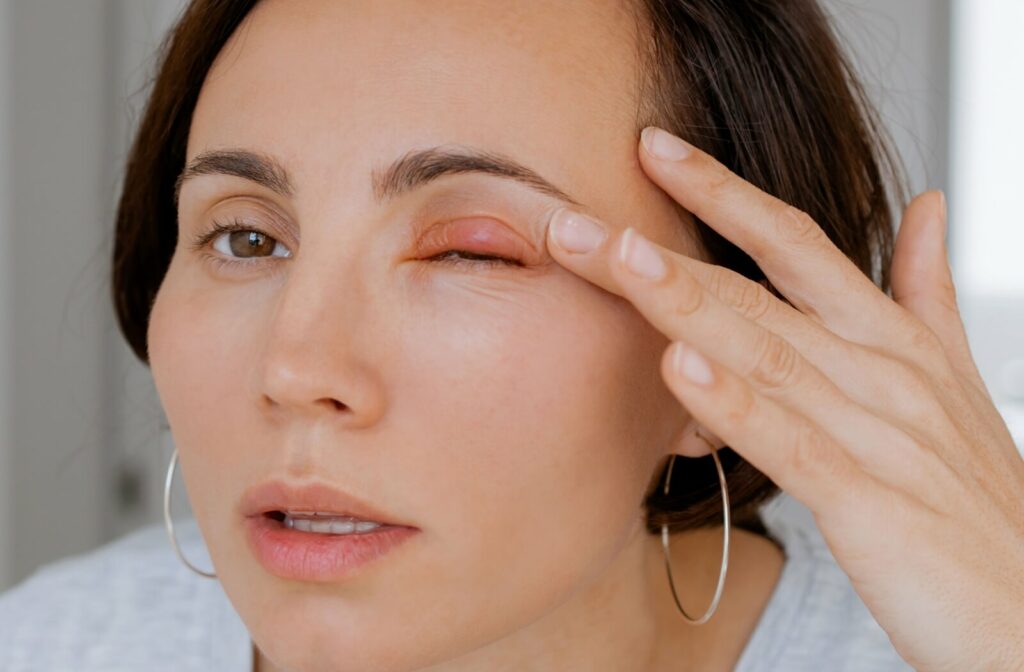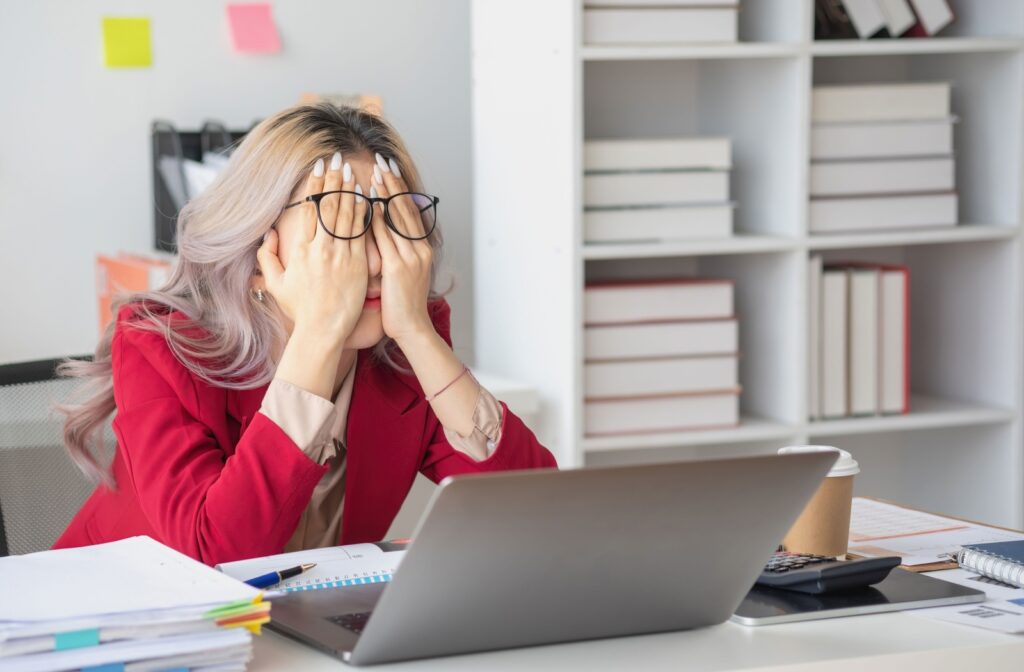Most of us have experienced stress at some point. It may have been during a high-pressure day at work, a tight deadline, or just the busyness of life.
During these stressful moments, the last thing anyone wants to add to their plate is a noticeable, red, and sometimes painful bump on their eyelid: a stye.
We commonly associate stress with mental well-being, and while it manifests differently in everyone, it can also take a toll on your physical health, including your eyes.
Stress may not directly cause styes, but it can contribute to their development. In moments of chronic stress, the immune response becomes weaker, the skin’s oil production can shift, and people tend to make poor eye hygiene choices, all of which pave the way for a stye to develop.
If you have a stye, don’t further stress yourself. Take a deep breath and visit your optometrist. Recovery is just around the corner.
How Stress Affects Eye Health
Stress can affect almost every part of the body, and your eyes are no exception.
In stressful moments, your body releases cortisol and other stress hormones, activating the “fight or flight” response. It may not sound concerning, but when stress becomes chronic, these hormones can disrupt various systems in your body, including your immune system, skin, and eyes.
Here’s how stress might affect your eye health:
- Weakened immune system: Chronic stress can compromise your immune system, leaving you more vulnerable to infections and inflammation, which are key culprits in styes.
- Dry eyes and strain: Prolonged stress can lead to eye strain, dry eyes, or eyelid twitching. Over time, this can leave your eyes more susceptible to irritation.
- Skin irritation: Stress can trigger conditions like eczema or make your skin’s oil glands overactive, including those near the eyelids.
Stress And Styes
A stye is a small, red, painful bump that usually forms along the edge of your eyelid. It happens when an oil gland or hair follicle gets clogged and infected, often by Staphylococcus bacteria.
Although chronic stress can contribute to the development of styes, it doesn’t directly cause the infection. It can however:
- Weaken the immune response, making your body less capable of fighting off bacteria before an infection sets in.
- Alter the skin’s oil production, causing glands on the eyelids to become clogged, paving the way for a stye.
- Encourage poor hygiene habits. People often rub their eyes more when under stress, potentially transferring bacteria from their hands to their eyelids. They might skip their skincare routine and go to bed without removing eye makeup, further contributing to stye development.
Though styes often look and feel uncomfortable, and sometimes interfere with daily activities (preventing you from wearing eye makeup or contact lenses) they’re not necessarily worrisome. Most styes are external and heal on their own within a week.
If you frequently experience styes or notice they take longer than usual to heal, this could signal an underlying health issue that’s worth visiting your eye doctor.

Stress Management & Stye Prevention
Preventing styes might require a two-fold approach: managing stress and maintaining good eye hygiene. This supports your overall well-being while reducing the effects of stress on the body.
Here’s how:
- Practice mindfulness: Techniques like meditation, yoga, and deep breathing exercises can help lower cortisol levels and reduce stress’s impact on your body.
- Practice proper hand hygiene: Always wash your hands before touching your eyes, especially if you wear contact lenses.
- Stay active: Regular exercise promotes healthy blood circulation and releases endorphins, naturally countering stress.
- Avoid rubbing your eyes: This reduces the chance of transferring bacteria to your eyelids.
- Sleep well: A good night’s sleep is essential for a healthy immune system and overall well-being.
- Maintain clean eyelids: Use a gentle eyelid cleanser or lukewarm water to keep your eyelid margins clean, especially before bed.
- Create balance: Manage your workload and set realistic expectations to avoid burnout.
- Replace old makeup: Expired or shared eye makeup can harbor bacteria. Replace mascara and eyeliner every three months, and don’t share products.
I Have A Stye: What Now
Sometimes, despite your best efforts, a stye may still develop. Don’t panic (and stress yourself further). The good news is that most styes are easily treatable at home.
The vast majority of styes heal within 7 to 10 days without causing any long-term issues. To encourage healing and reduce discomfort, visiting your eye doctor (amongst other strategies) can help:
- Warm compress: Apply a warm compress to the affected eye for 10–15 minutes, 3–4 times a day. This encourages the stye to drain naturally.
- Gentle cleansing: Use a gentle, non-irritating eyelid cleaner to keep the area clean. Avoid harsh soaps or chemicals.
- Avoid squeezing: Never pop or squeeze a stye, as this can worsen the infection or spread bacteria.
- Stay makeup and contact lens-free: Skip eye makeup and opt for eyeglasses when you have a stye to prevent irritation and reinfection.
- Over-the-counter relief: If the stye feels particularly painful, use a mild, over-the-counter pain reliever like ibuprofen.
If the stye persists for over two weeks or worsens despite your efforts, visit your optometrist right away. Timely intervention encourages healing and can prevent a small concern from snowballing into something greater.
Healthy Mind, Healthy Eyes
Beyond your mental health and well-being, chronic stress can manifest as physical signs, from a weak immune system to styes.
Although we can’t account for every curveball life throws our way, we can support our health by taking control of what we can. With proper stress management and eye hygiene, you can safeguard your vision and your overall well-being.
If you’re managing a stye infection or concerned about eye irritation, don’t wait to seek help. Connect with Dr. Jennifer L. Shane & Associates to schedule a visit.



